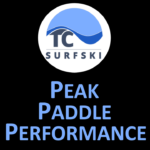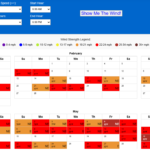Below I am re-posting a great write-up that Erik Borgnes put together outlining his summer training approach to prepare for the Chattajack 31 taking place this year on Oct 28th. Erik has a definite talent for understanding the latest and most proven literature on endurance training and translating that into structured plans that deliver great results.
The below may not be for everyone, but it gives insight and very real numbers on what it takes if you want to win the race. You could easily set a goal of “x percent” off the winner and then recalibrate all the numbers below to align.
Hope you enjoy – I felt that this was a wealth of information that Erik took the time to compile and certainly worth sharing beyond just the Kayak ERG Yahoo group.
Summer training for the Chattajack By Erik Borgnes
Below is the program that I will follow with the caveat being that I will probably only do 3 out of 4 of the workouts listed for reasons of work, vacation, family time, illness, feeling too tired, etc, so view the list more or less as milestones for how much volume of what to do and how to taper. The most important workouts will be the LSD sessions which will allow you to complete the Chattajack race comfortably. The 1 mile interval sessions will allow you to develop a good fast pace for the majority of the distance. The “1/4 mile intervals” and the “max efforts” give you the ability to adjust your pace or effort as necessary without dying and should add to a feeling of general strength in the boat. I’ve listed the flat water speeds that I do so that you can see how much mine vary. If you do other races this summer, just cut the previous week’s volume in half.
- “LSD” training is long, slow, distance training. Pace is at upper level conversation pace. The focus is on depletion of muscle and liver glycogen so that you no longer bonk. Don’t plan on eating and drinking your way through a race of 4-6 hrs length as the carbs you take in won’t really help you, so do these LSD sessions with only water and consider doing them after a 6 hr to 24 hr fast. (My LSD pace is about 6.8-7.0 mph). The “training effect” only begins after you’ve paddled for about 2 hrs.
- “Marathon pace” is the fastest avg pace that you could hold on flat water for an hour at max effort. Learn what your HR is at this pace as if there’s a mild headwind in one direction then you can go by speed when paddling with the breeze and HR when paddling into the breeze. This is the only workout that I do when a HRM is really helpful because you don’t want to paddle too hard nor too slow. As these increase in number on the schedule to greater than 12 or so in a workout, I’ll target the lower margin of my marathon range, i.e. 7.7 mph. (My marathon pace interval is about 7.7-8.0 mph and I’ll target a HR range of about 162-165. I’ll avg the Chattajack at about 7.5 mph equivalent speed)
- “1/4 mile interval” pace is about 30% harder than marathon pace. The goal is to build power endurance. These are about 1 min 30 sec long. You want to feel muscle fatigue but not cardiovascular fatigue, i.e. select an interval length that ends before you start to feel in oxygen debt and that you feel completely recovered from 20 seconds afterwards. 3-5 minute rest in between. ( I target about 8.7 mph from the rolling start and aim to keep speed above 8.3 mph for each)
- “max effort” pace is just that, i.e. maximal efforts from a rolling start. Think of these as sport specific weight training. 1-2 minute rest in between. (I’ll roll the start at about 7.0 mph and get up to about 9.3-9.5 mph for each)
None of the above training is max HR, max oxygen debt, or max effort until you “feel like puking” type of training. You can get bits of that from an occasional run or bike ride.
I’m always worried about overtraining but don’t seem to have problems with what I do. Too high volume and too much time in “the red zone” above marathon pace HR are the factors that lead to overtraining. You’ll notice that as the LSD and 1 mile intervals increase in volume, I’ve combined the two into the same workout to limit the overall training load. For these, do a long warmup then do the 1 mile intervals and then more LSD if needed to complete the time. Also, if I get the opportunity to join a friend and do a downwind paddle on a larger lake, I might make it an upwind/downwind to get my LSD time in, and I’ll of course count that session as my 30 stroke max effort session as downwind paddles are more or less a series of short sprints.
Again, I plan to be hitting the LSD, 1 mile marathon pace, and 1/4 mile interval milestones detailed below, but I’ll only end up doing 3/4 of the sessions for a variety of reasons. There are 4 sessions per week initially, then 3 per week. I’m usually on an every-other-day paddling schedule for reasons of needing recovery time. I’ll add in maybe a 2 hr bike ride and a 30 minute run each week, too.
May and June: Work up to 3 hrs LSD, 6 x 1 mile at marathon pace; 12 x 1/4 mile intervals.
July
- Week 1: 3 hrs LSD; 6 x 1 mile at marathon pace; 12 x 1/4 mile intervals; 20 x 30 stroke max effort
- Week 2: 4 hrs LSD; 6 x 1 mile at marathon pace; 12 x 1/4 mile intervals; 20 x 30 stroke max effort
- Week 3: 3 hrs LSD; 6 x 1 mile at marathon pace; 12 x 1/4 mile intervals; 20 x 30 stroke max effort
- Week 4: 4 hrs LSD; 6 x 1 mile at marathon pace; 15 x 1/4 mile intervals; 20 x 30 stroke max effort
August
- Week 1: 3 hrs LSD; 6 x 1 mile at marathon pace; 16 x 1/4 mile intervals; 20 x 1/4 mile intervals
- Week 2: 4 hrs LSD; 6 x 1 mile at marathon pace; 16 x 1/4 mile intervals; 20 x 1/4 mile intervals
- Week 3: 3 hrs LSD; 8 x 1 mile at marathon pace; 18 x 1/4 mile intervals; 20 x 30 stroke max efforts
- Week 4: 4 hrs LSD; 10 x 1 mile at marathon pace; 18 x 1/4 mile intervals; 20 x 30 stroke max efforts
September
- Week 1: 4 hrs with 12 x 1 mile at marathon pace; 20 x 1/4 mile intervals; 20 x 30 stroke max efforts
- Week 2: 4 hrs with 14 x 1 mile at marathon pace; 20 x 1/4 mile intervals; 20 x 30 stroke max efforts
- Week 3: 5 hrs with 16 x 1 mile at marathon pace; 18 x 1/4 mile intervals; 20 x 30 stroke max efforts
- Week 4: 5 hrs with 18 x 1 mile at marathon pace; 18 x 1/4 mile intervals; 20 x 30 stroke max efforts
October
- Week 1: 5 hrs with 18 x 1 mile at just below marathon pace; 18 x 1/4 mile intervals; 20 x 30 stroke max efforts
- Week 2: 4 hrs with 14 x 1 mile at just below marathon pace; 16 x 1/4 mile intervals; 20 x 30 stroke max efforts
- Week 3: 3 hrs with 9 x 1 mile at marathon pace; 12 x 1/4 mile intervals; 20 x 30 stroke max efforts
- Week 4: Something higher pace but not too high volume, i.e. 2 hrs with 10 x 30 stroke max efforts + 2 x 1/2 mile at marathon pace; 1-2 hrs with 6 x 1/2 mile at just below marathon pace.




